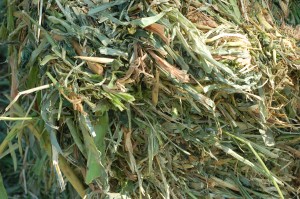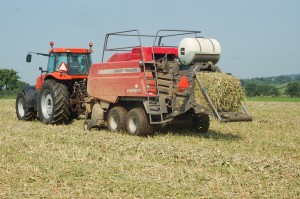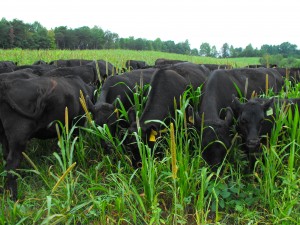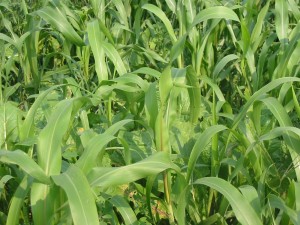Genevieve Slocum
The need for soil building, erosion control and nutrient scavenging doesn’t end with the onset of warm weather; if anything, it only accelerates. It’s an opportunity to be seized, especially since warm season annuals establish quickly, fill gaps in the rotation, tolerate drought and other challenging conditions, and produce large amounts of forage or biomass in as little as 30-40 days. These benefits combined help you stretch your supplies and/or build your organic matter, depending on your goals.
Even a simple mix of two or three species can work wonders for your fields this summer, whether it is for cover crop use, forage, or both. A mix left as strictly a cover crop will provide close to its potential maximum organic matter and nitrogen fixation to soil, but a crop taken as forage will provide many of the same benefits and maximize your land value. More and more often, we are working with producers who are searching for that key combination that can provide a productive “double duty” forage and cover crop.
Whether you have two species or ten, carefully considering the benefits of each is important. Most summer cover crop species work well together to provide a unique, synergistic benefit, especially when you take care to balance grasses with legumes and broadleaves.
A mix of two or more species is almost always preferable to a straight stand. Not only are you packing the benefits from multiple species, you’ve diversified your risk rather than relying on the performance of one species.
Combining different species also creates balance between nitrogen fixers (legumes) and nitrogen users (grasses and forbs), deep and shallow root structures, below- and above-ground niches for nutrients, water, and light, and crops with varying carbon to nitrogen ratios (C:N). Different proportions of carbon to nitrogen causes the crop residue to mineralize nitrogen at different rates – moderating N release and creating balance between N immobilization (caused by higher C:N ratio) and large flushes of nitrate (lower C:N ratios). The amount of carbon overall in the mix will help determine how quickly the residue breaks down and releases nutrients, although some species will be much higher or lower than the average. Each component also has a slightly different allelopathic effect, which helps inhibit the germination of different weed species. Many species also flower and attract beneficial insects, creating a break crop for pests, and lower-growing, canopy-forming species suppress weeds.
The following combinations work nicely in a double-crop rotation with a winter annual small grain forage or blend, such as barley and ryegrass or triticale and crimson clover. In the Mid-Atlantic and south, you may also be able to fit in a third cool season annual like forage oats and spring peas before or after the summer annual.
MasterGraze and Cowpeas: High Quality Forage, Weed Control and Break Crop

MasterGraze, a BMR tillering corn that is ready for grazing in 60 days, really benefits from the addition of cowpeas, a vining summer legume. It is a highly productive forage to extend corn silage supplies as well, and works for grazing during the time when cool season grasses enter the “summer slump”. Mastergraze can be slow to take off, and the leafy cowpeas suppress weeds in the gaps before the MasterGraze canopy closes. Cowpeas have been substituted for soybeans in this role, mostly because they make a more palatable forage and their viney nature makes the Mastergraze an ideal “trellis” to support their growth. Cowpea has a deep taproot to weather drought, and fixes nitrogen as well.
MasterGraze is a corn and must be planted with a corn planter, and is often planted in 15-inch rows at approximately a 44,000 population (double back to split the rows with a 30-inch spaced corn planter). To establish cowpeas, go back over the field with a drill in a perpendicular direction to the MasterGraze planting at approximately 40 lbs/A.
As for feeding, if harvested or grazed just before tasseling, the mix will produce at least 12% protein, but actually feeds at a higher level than this because MasterGraze is so digestible at this stage, and often protein supplementation won’t be needed. This mix can be difficult to handle just because it produces so much material. It can be grazed, direct chopped and fed as green chop, or cut, wide swathed and then tedded 3-4 hours after cutting left to wilt and then windrowed and baled. Success can be had with baleage, although it will be more of a challenge. Because of the sheer mass of the material, raking and tedding increases ash content and lowers forage quality. For that reason, we’d much rather see the crop in a grazing or green-

chop scenario.
Cowpeas fit well with BMR sorghum-sudan and sudangrass products as well, but the MasterGraze gives a premium in yield, protein, and digestibility, and those who use this combination to stretch corn silage supplies report a smooth transition with no drop in milk production.
Ray’s Crazy Mix: Soil Building Diversity and Grazing for Beef Cattle and Dry Cows
This mix was developed to maximize diversity and flexibility in a short window of opportunity. With seven species, summer grasses (millet and sorghum-sudan) are balanced out by legumes, brassicas and sunflower. Cowpeas fix nitrogen and create a shading, weed-suppressing canopy effect, while grasses build soil with fibrous roots. Allowing the crop to grow longer produces more biomass and lets the cowpeas fix the most nitrogen.

If you notice a weedy or thinning pasture, it may be time for a break. The diversity in Ray’s Crazy Mix makes it an excellent break crop for renovating pastures. Terminate a pasture in the spring, then plant Ray’s Crazy Mix before reseeding a pasture mix in the fall. The unique blend of species will disrupt weed and pest pressure and build soil with roots and above-ground growth. The mix grows quickly and keeps ground covered, and tolerates stressful conditions like heat, drought, and poor soil. In addition to a nitrogen-fixing legume, cowpea, the mix contains several deep rooted components, such as Daikon radish and sunflower, which scavenge and hold nutrients for the following crop. The radish’s thick tuber root also helps penetrate and break up compacted soils. Left to bloom, components like the sunflower, cowpea, and brassica will attract many types of beneficial insects.
Ray’s Crazy Mix will provide high quality, highly digestible forage, though dairy cows can be more

particular about selecting it than beef cattle – they may especially shy away from the brassica and sunflower components, depending on what they are accustomed to. This mix makes an excellent dual application as cover crop and forage, but is best approached primarily as a cover crop and secondarily as a forage. Just be sure to take special care when placing it in a forage application.
The mix will reach the ideal combination of quality and yield when the millet and sorghum-sudan reach 18-20 inches. Past this point, lignin content increases, reducing digestibility. Deciding whether you are maximizing biomass for soil health or targeting optimal quality for grazing will help determine management of the crop as it reaches maturity. For best regrowth, stop grazing at a 6 inch stubble height.
The mix is best suited for grazing, since the brassica component is high in moisture and low in lignin, which makes it difficult to dry for baleage.

Summer Feast –Grazing that also works as a cover crop
Summer feast, or a variant on this mix, is the crop that many graziers actually want when they ask for Ray’s Crazy Mix. It’s diversity and digestibility in two species. Comprised of Wonderleaf Pearl Millet and Forage Brassica, it’s a high-protein, high-energy blend of varieties that complement each other well both in the field and in the barn. Millet, a summer annual grass, provides effective fiber to slow the rate of passage of the brassica’s rich quality. The brassica itself contains as much or more protein as a legume. Agronomically, brassicas have an allelopathic effect on weeds and a biocidal effect on some pests. They also take up lots of physical space, producing a natural weed-suppressing canopy beneath the grass with their broad leaves. The combination presents two physical levels of grazing for the animal.
This mix provides a good answer for those who want a highly nutritious grazing mix first, and a solid cover crop second. It doesn’t provide the sprawling diversity of Ray’s Crazy Mix, but if you target the mix carefully to your needs, you may not need as much diversity as you think you do.
Again, grazing is the ideal application for this crop, as the brassica is higher moisture and more difficult to dry.
Other custom mixes to fit soil and livestock needs
Summer Feast is a pre-made mix, but if you want to make your own formula it has several good stand-ins. You could substitute MasterGraze, sudangrass or sorghum-sudan for the millet and still achieve a similar effect. We also now carry Exceed millet, a brown midrib product that is more digestible and lower in lignin than Wonderleaf. Just be aware that sorghum-sudans and sudangrasses have prussic acid danger after frost, while millet does not.
It is quite likely that a two or three species mix will be enough to fulfill your soil or livestock needs. Mix and match one or two warm season grasses, a brassica, and/or a legume. For strictly cover crop uses, buckwheat and sunn hemp, both excellent smother crops and soil builders, can be added. Consult with a King’s AgriSeeds rep to determine which species work best with your specific plans.
No matter what your cropping scenario is : Summer annuals help
No matter which mix you decide on, summer annuals are a boon to your rotation. They diversify a pasture or agronomic cropping situation and can help mitigate many of the problems you may be having. Most of them provide high quality forage, too, and in a time crunch, you could be surprised at their ability to stretch your forage inventory in a shorter growing window than corn silage, and to be productive at a time of year when your staple pastures are waning.
Speak to an expert at King’s AgriSeeds now at 1-717-687-6224 or email us at [email protected].

2 Comments. Leave new
With the mastergraze and cowpeas program is a chemical weed control needed other than an initial burndown before planting?
thanks Lon
Lon, in our experience no weed control is needed with this mix because the cowpeas fill in the gaps to shade out most weeds before the corn’s canopy closes. As long as you have good pre-plant weed control with a broad spectrum herbicide you should be fine. Also this crop only grows about 60 days or less, so we would have to be careful with any residuals for the following crop.